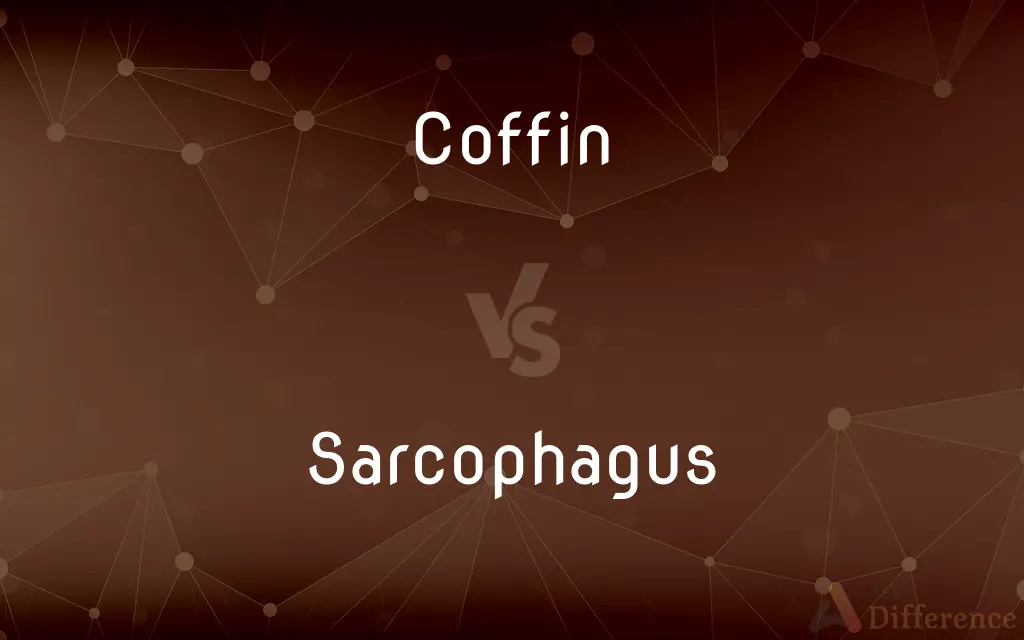Coffin vs. Sarcophagus — What's the Difference?
By Fiza Rafique & Urooj Arif — Updated on April 2, 2024
Coffins are typically wooden burial boxes with a tapered shape, designed for individual human bodies, whereas sarcophagi are stone containers often elaborately decorated and used primarily in ancient times.

Difference Between Coffin and Sarcophagus
Table of Contents
ADVERTISEMENT
Key Differences
Coffins, known for their use in modern burial practices, are designed to directly contain the human body, usually featuring a simple, tapered shape and made primarily of wood. Whereas sarcophagi, which date back to ancient civilizations like Egypt, Rome, and Greece, are stone containers used to encase already coffin-contained bodies or mummies, often elaborately decorated to honor the deceased.
While coffins are commonly associated with Christian burial practices, offering a range of styles from simple to elaborate, depending on cultural and personal preferences, sarcophagi were used by ancient civilizations not just for their protective qualities but also as a status symbol, showcasing intricate artworks and inscriptions about the deceased.
Coffins are chosen based on the immediate needs of burial, emphasizing practicality, and affordability, with options in materials ranging from simple wood to metal and eco-friendly alternatives. On the other hand, sarcophagi were crafted from durable materials like stone or marble, designed to last for millennia and often placed within tombs or burial chambers as part of elaborate funeral rites.
The design of coffins, with their tapered or rectangular shape, is meant to reflect the human form and can be personalized to reflect the life and preferences of the deceased. Sarcophagi, however, are distinguished by their grandeur and historical significance, with designs that include symbolic imagery, inscriptions, and sculptures intended to guide and protect the deceased in the afterlife.
Despite their differences, both coffins and sarcophagi serve the fundamental purpose of honoring and protecting the deceased, with their respective designs and materials reflecting the cultural, religious, and personal beliefs of the society or individual they are intended for.
ADVERTISEMENT
Comparison Chart
Material
Primarily wood, but can include metal and eco-friendly materials.
Usually stone, such as limestone, marble, or granite.
Shape
Tapered to conform to the human body shape; also available in rectangular forms.
Box-like, often rectangular, with elaborate exteriors.
Use
Used in modern burials to directly contain the body.
Used in ancient times to encase a coffin or mummy, primarily for protection and display.
Decoration
Can be simple or elaborate, typically less ornate than sarcophagi.
Highly decorative, often with carvings, sculptures, and inscriptions.
Cultural Context
Common in Christian burials and widespread across various cultures today.
Associated with ancient civilizations, such as Egyptian, Roman, and Greek.
Compare with Definitions
Coffin
A tapered or rectangular burial box for humans.
The wooden coffin was adorned with flowers at the funeral.
Sarcophagus
A stone container for a coffin or mummy, used in ancient times.
The museum's exhibit featured an intricately carved sarcophagus from Egypt.
Coffin
Made primarily from wood, but can also be metal or eco-friendly materials.
They chose a biodegradable coffin made from bamboo.
Sarcophagus
Crafted from durable materials like stone, marble, or granite.
The granite sarcophagus bore inscriptions that told the deceased's story.
Coffin
Simpler in decoration compared to sarcophagi, emphasizing practicality and personalization.
Despite its simplicity, the coffin's elegant design paid tribute to a well-lived life.
Sarcophagus
Associated with elaborate funeral rites of ancient civilizations.
Archaeologists discovered a sarcophagus that revealed much about Roman burial practices.
Coffin
Designed to reflect the human form, can be personalized.
The family selected a custom coffin painted to honor the deceased's love of nature.
Sarcophagus
Elaborately decorated, often with carvings and inscriptions.
The sarcophagus's exterior was adorned with scenes from mythology.
Coffin
Used in modern burial practices across various cultures.
The coffin was carried to the grave in a traditional burial ceremony.
Sarcophagus
Serves as a protective and honorary vessel, reflecting the deceased's status and beliefs.
The sarcophagus was designed to ensure the king's journey to the afterlife was peaceful.
Coffin
A long, narrow box, typically of wood, in which a dead body is buried or cremated
They lowered her coffin into the ground
Sarcophagus
A sarcophagus (plural sarcophagi or sarcophaguses) is a box-like funeral receptacle for a corpse, most commonly carved in stone, and usually displayed above ground, though it may also be buried. The word "sarcophagus" comes from the Greek σάρξ sarx meaning "flesh", and φαγεῖν phagein meaning "to eat"; hence sarcophagus means "flesh-eating", from the phrase lithos sarkophagos (λίθος σαρκοφάγος), "flesh-eating stone".
Coffin
An oblong box in which a corpse is buried.
Sarcophagus
A stone coffin, often inscribed or decorated with sculpture.
Coffin
The horny part of a horse's hoof.
Sarcophagus
A stone coffin, often with its exterior inscribed, or decorated with sculpture.
Coffin
To place in or as if in a coffin.
Sarcophagus
(by extension)
Coffin
(cartomancy) The eighth Lenormand card.
Sarcophagus
(informal) The cement and steel structure that encases the destroyed nuclear reactor at the Chernobyl Nuclear Power Plant in Chernobyl, Ukraine.
Coffin
(archaic) A casing or crust, or a mold, of pastry, as for a pie.
Sarcophagus
(historical) A type of chilled]] shaped like a sarcophagus (sense 1).
Coffin
(obsolete) A conical paper bag, used by grocers.
Sarcophagus
A kind of limestone used by the Ancient Greeks for coffins, so called because it was thought to consume the flesh of corpses.
Coffin
The hollow crust or hoof of a horse's foot, below the coronet, in which is the coffin bone.
Sarcophagus
(transitive) To enclose (a corpse, etc.) in a sarcophagus (noun sense 1).
Coffin
A storage container for nuclear waste.
Sarcophagus
A species of limestone used among the Greeks for making coffins, which was so called because it consumed within a few weeks the flesh of bodies deposited in it. It is otherwise called lapis Assius, or Assian stone, and is said to have been found at Assos, a city of Lycia.
Coffin
(transitive) To place in a coffin.
Sarcophagus
A coffin or chest-shaped tomb of the kind of stone described above; hence, any stone coffin.
Coffin
A basket.
Sarcophagus
A stone shaped like a sarcophagus and placed by a grave as a memorial.
Coffin
A casing or crust, or a mold, of pastry, as for a pie.
Of the paste a coffin I will rear.
Sarcophagus
A stone coffin (usually bearing sculpture or inscriptions)
Coffin
A conical paper bag, used by grocers.
Coffin
The hollow crust or hoof of a horse's foot, below the coronet, in which is the coffin bone.
Coffin
To inclose in, or as in, a coffin.
Would'st thou have laughed, had I come coffined home?
Devotion is not coffined in a cell.
Coffin
Box in which a corpse is buried or cremated
Coffin
Place into a coffin;
Her body was coffined
Common Curiosities
Were sarcophagi used exclusively in Egypt?
No, sarcophagi were used in various ancient civilizations, including Roman and Greek societies.
Why are sarcophagi so elaborately decorated?
The elaborate decorations served both to honor the deceased and to reflect their status, beliefs, and the cultural significance of the afterlife.
Do coffins degrade over time?
Yes, depending on the material, coffins can degrade over time, especially those made from biodegradable materials designed for eco-friendly burials.
Can a coffin be made from materials other than wood?
Yes, coffins can also be made from metals, eco-friendly materials, and even biodegradable options.
Are all coffins shaped to match the human body?
Most coffins are tapered or rectangular to reflect the human form, but shapes can vary based on cultural practices and personal preferences.
How do the purposes of coffins and sarcophagi compare?
Both serve to honor and protect the deceased, though sarcophagi, with their elaborate designs, also played a role in ancient funeral rites and afterlife beliefs.
Is the use of sarcophagi still common today?
While not common in contemporary burial practices, sarcophagi remain significant in historical and archaeological contexts.
Can sarcophagi be found outside of ancient tombs?
Yes, sarcophagi are often displayed in museums around the world, providing insights into ancient cultures.
What is the main difference between a coffin and a sarcophagus?
The main difference lies in their materials and use; coffins are primarily wooden and used in modern burials, while sarcophagi are stone containers from ancient times, often more elaborately decorated.
How are modern burial practices influenced by ancient traditions involving sarcophagi?
Modern practices may draw inspiration from ancient rituals in terms of honoring the deceased and the use of art and symbolism in memorials.
What cultural significance do coffins and sarcophagi hold?
Both reflect the burial practices, religious beliefs, and societal values of the cultures they originate from.
Can anyone be buried in a sarcophagus?
Historically, sarcophagi were reserved for individuals of higher status or wealth, reflecting their importance and beliefs about the afterlife.
What materials are considered eco-friendly for coffins?
Bamboo, cardboard, and other biodegradable materials are considered eco-friendly options for coffins.
Share Your Discovery

Previous Comparison
Careless vs. Clumsy
Next Comparison
Dependence vs. DependencyAuthor Spotlight
Written by
Fiza RafiqueFiza Rafique is a skilled content writer at AskDifference.com, where she meticulously refines and enhances written pieces. Drawing from her vast editorial expertise, Fiza ensures clarity, accuracy, and precision in every article. Passionate about language, she continually seeks to elevate the quality of content for readers worldwide.
Co-written by
Urooj ArifUrooj is a skilled content writer at Ask Difference, known for her exceptional ability to simplify complex topics into engaging and informative content. With a passion for research and a flair for clear, concise writing, she consistently delivers articles that resonate with our diverse audience.














































